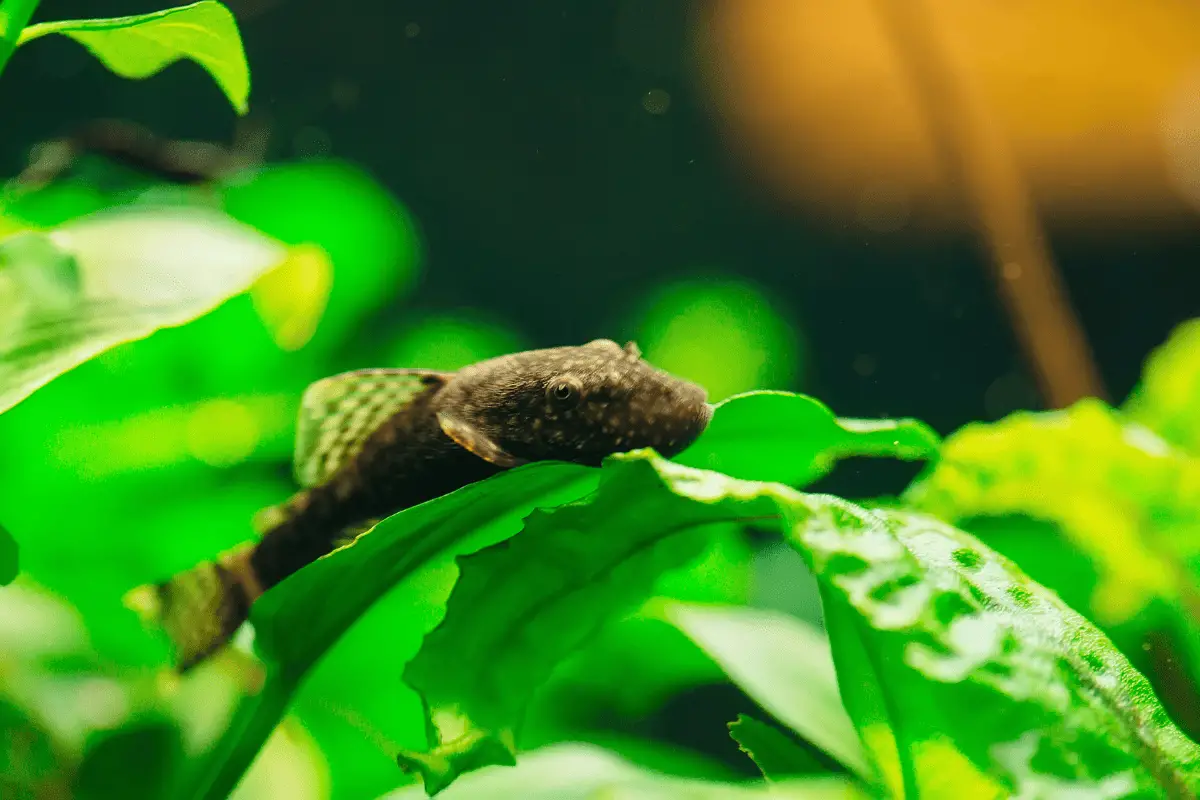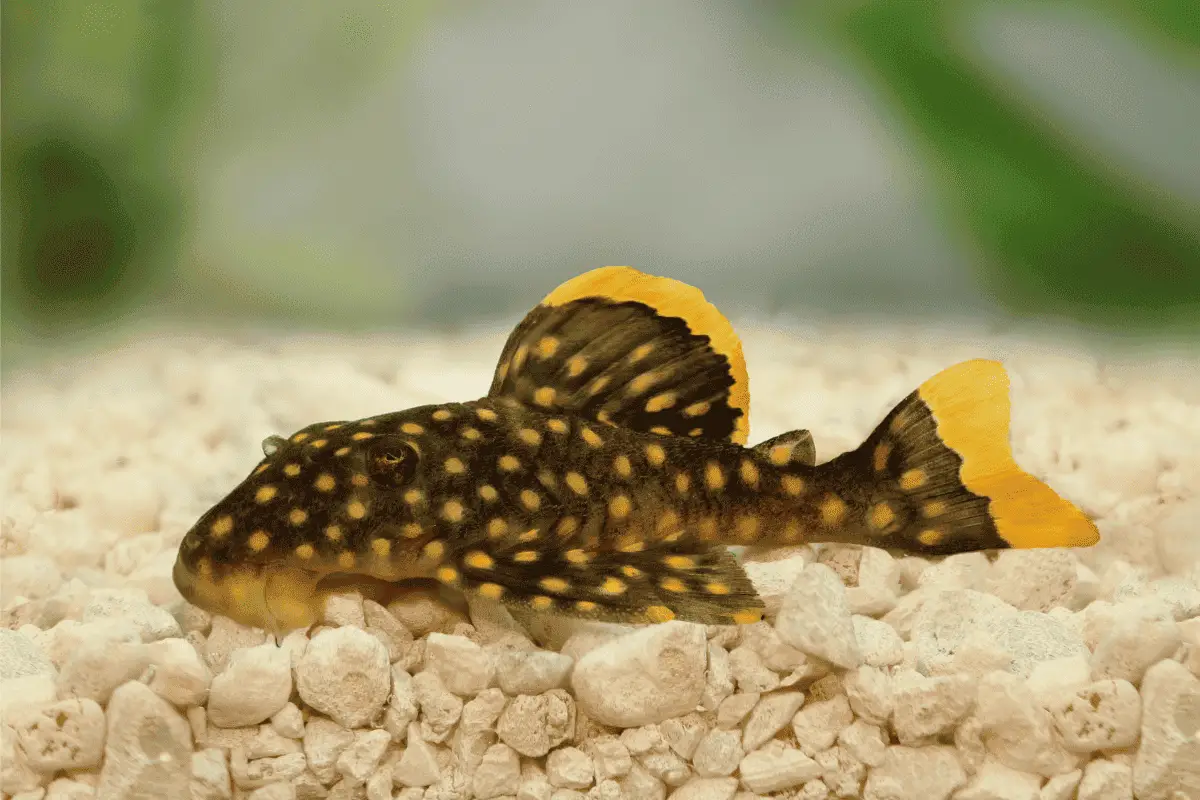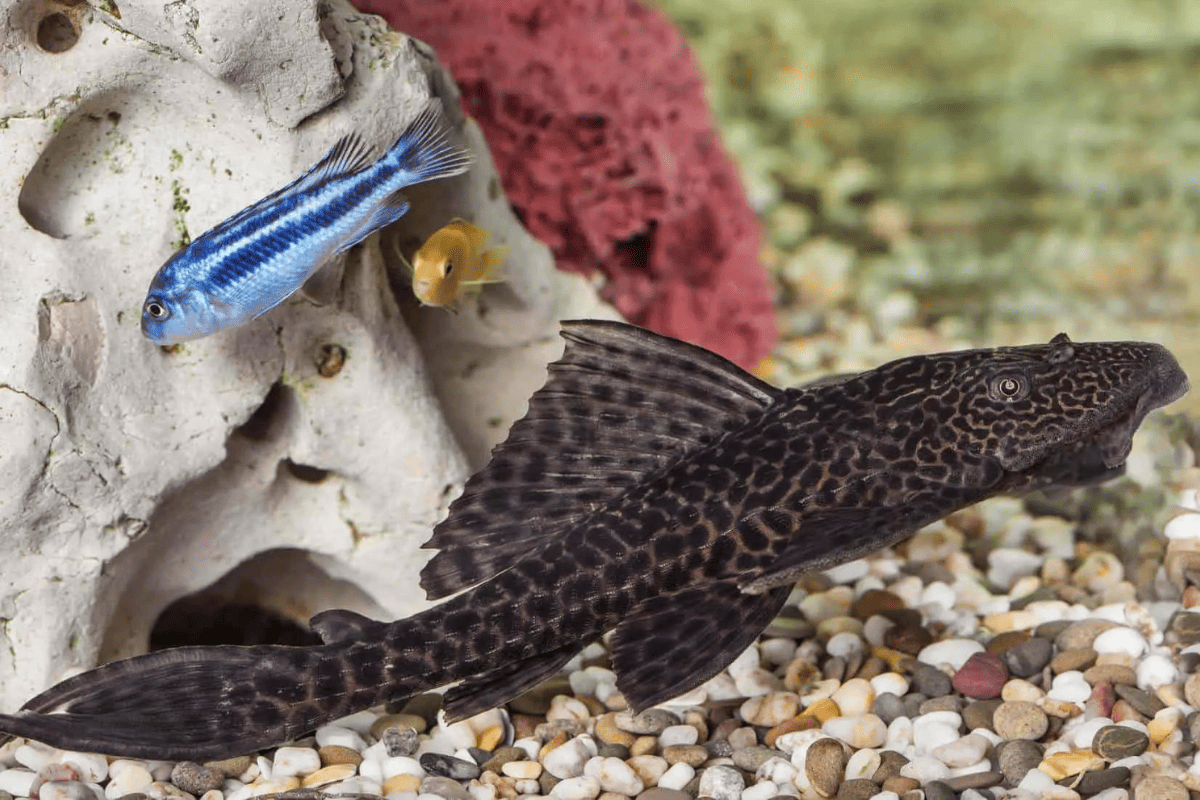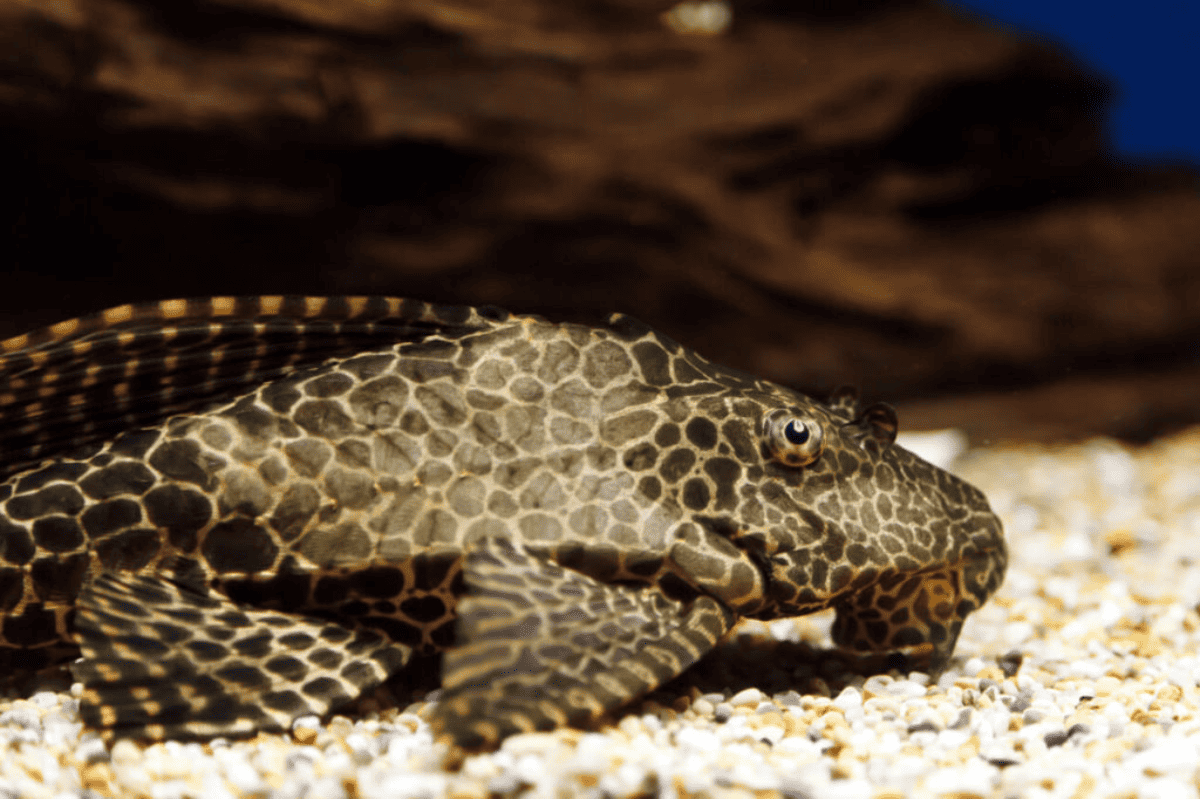Plecos and Arowanas are both favorites in freshwater tanks. But is it okay for them to share the same space?
What should you think about when housing them together? How should the tank be set up, and what are their water and food needs?
Which Pleco varieties work best with this combo, and which ones are a no-go? And who else can join them in the tank?
In this article, I’ll dive into all these topics and more, ensuring you walk away with all the information you need. Let’s get started.

Can I Keep Plecos and Arowanas Together in the Same Tank?
Yes, Plecos and Arowanas can coexist in the same tank. However, certain conditions and considerations must be met for their successful cohabitation.
- Size Compatibility: Plecos, depending on the species, can grow between 6 to 24 inches. Arowanas can exceed 30 inches. Both fish require ample space, preferably a tank size starting at 250 gallons.
- Diet Overlap: Arowanas are carnivorous, eating insects and small fish. While Plecos are mainly herbivores, they do eat small invertebrates, ensuring there’s no competition for food.
- Bottom vs. Top Dweller: Plecos primarily inhabit the bottom of the tank, while Arowanas are surface dwellers. This vertical separation minimizes territorial disputes.
- Aggressive Nature: Arowanas can be aggressive, especially when feeling threatened. Plecos, with their armored bodies, are less likely to be injured by such aggression.
- Temperature Requirements: Both Plecos and Arowanas prefer warm water, typically between 76°F to 86°F, ensuring similar environmental needs within the tank.
Also Read: Pleco Fish Tank Mates
Plecos vs. Arowanas: Behavior
When it comes to behavior, there are some key differences between Plecos and Arowanas you should be aware of:
Pleco Fish: Natural Behavior
Plecos are mostly active at night and often stick to hiding spots or latch onto surfaces.
They’re chill fish that hang out at the bottom of the tank, focusing more on cleaning up algae than socializing with their tank mates.
- Night Owls: Plecos really come alive at night, foraging for food while most of their tankmates are snoozing.
- Suction Experts: Thanks to their specialized mouths, Plecos stick to surfaces to munch on algae and biofilm, aiding in keeping the tank clean.
- Wallflowers: During the day, you’ll often find Plecos hiding under rocks or tucked away in caves, where they feel safe.
- Peace Lovers: For the most part, Plecos avoid fights and would rather steer clear of drama with other fish in the tank.

Arowanas: Natural Behavior
Arowanas are energetic swimmers who usually stick to the top part of the tank. They’re natural predators and are known to leap out of the water when hunting in the wild.
- Top Dwellers: Arowanas prefer to swim near the surface, where they keep an eye out for potential meals.
- High Jumpers: In their natural habitat, Arowanas leap to snag insects and other prey, so make sure your tank has a sturdy cover to keep them from jumping out.
- Born Hunters: With their large mouths, Arowanas eat insects, smaller fish, and sometimes even birds in the wild.
- Lone Wolves: Arowanas like their personal space and can sometimes show aggressive tendencies towards other fish sharing their tank.

Ideal Parameters for Plecos and Arowanas
To keep Plecos and Arowanas healthy, you’ll need to pay attention to specific water conditions.
The table below highlights the differences and recommends conditions for tanks housing both.
| Parameter | Plecos | Arowanas | Both Types |
| Temperature | 74°F – 80°F (23°C – 27°C) | 75°F – 86°F (24°C – 30°C) | 76°F – 80°F (24°C – 27°C) |
| pH Level | 6.5 – 7.5 | 6.0 – 7.5 | 6.5 – 7.5 |
| Water Hardness | 5 – 15 dGH | Up to 8 dGH | 5 – 10 dGH |
Pleco Fish: Ideal Parameters
Plecos thrive in warm, slightly acidic to neutral waters with moderate hardness. They are originally from freshwater rivers and streams of South America.
- Temperature: Plecos prefer a temperature range of 74°F to 80°F (23°C to 27°C).
- pH Level: An ideal pH level for Plecos is between 6.5 to 7.5, making it slightly acidic to neutral.
- Water Hardness: Soft to moderately hard water is preferable, with a dGH between 4 to 15.

Arowana Fish: Ideal Parameters
Arowanas also come from tropical freshwater environments, but they are a bit more adaptable in terms of water parameters than Plecos.
- Temperature: Arowanas thrive in temperatures between 76°F to 86°F (24°C to 30°C).
- pH Level: They can tolerate a wider pH range, from 6.0 to 7.5, but usually prefer slightly acidic conditions.
- Water Hardness: Similar to Plecos, Arowanas prefer soft to moderately hard water, typically with a dGH between 5 to 15.

Plecos vs. Arowanas: Tank Setup
Plecos and Arowanas have different habitat needs. Here’s a comparison of their preferred tank setups and a setup that caters to both.
| Setup Aspect | Plecos | Arowanas | Both Types |
| Ammonia | 0 ppm | 0 ppm | 0 ppm |
| Nitrite | 0 ppm | 0 ppm | 0 ppm |
| Nitrate | <20 ppm | <20 ppm | <20 ppm |
| Tank Size | >50 gallons | >150 gallons | >200 gallons |
| Foliage | Dense plants | Sparse plants | Moderate plants |
| Decorations | Driftwood, caves | Minimal, avoid sharp edges | Driftwood, rounded rocks |
| Filter | Robust | Strong | Very strong |
| Heater | Required | Required | Required |
| Substrate | Fine-gravel, sand | Sand, fine-gravel | Fine-gravel, sand |
| Pump | Moderate | Strong flow | Strong flow |
| Lighting | Moderate | Moderate to Bright | Moderate |
Pleco Fish: Tank Setup
Plecos, being primarily bottom-dwelling scavengers, have specific requirements when it comes to the tank setup.
These requirements help to recreate their natural environment and ensure their health and wellbeing.
- Ammonia Nitrite Nitrate: Plecos are sensitive to water quality, so ammonia and nitrite levels should always be zero, with nitrates kept under 40 ppm.
- Tank Size: A minimum of 55 gallons is required for most Plecos, but some species, which grow larger, may need up to 150 gallons.
- Foliage: Live plants and dense foliage provide Plecos with hiding spots and grazing areas.
- Decorations: Caves and driftwood pieces are essential, as Plecos use them for hiding and for rasping surfaces.
- Filter: A robust filtration system is crucial, given the Pleco’s messy feeding habits.
- Heater: Plecos need a stable temperature, making heaters, preferably with a thermostat, essential.
- Substrate: Sand or fine gravel substrates are ideal, allowing Plecos to scavenge comfortably.
- Pump: A moderate water flow, replicating river environments, is preferred, requiring a good quality pump.
- Lighting: Dimmed or subdued lighting aligns with the Pleco’s nocturnal nature, ensuring they’re not stressed.

Arowana Fish: Tank Setup
Arowanas are large, active swimmers that require spacious tanks with particular attention to the top layer and water quality.
- Ammonia Nitrite Nitrate: Arowanas, like Plecos, are sensitive, so it’s crucial to maintain ammonia and nitrite at zero and nitrates low.
- Tank Size: Given their size, a minimum of 250 gallons is advised for Arowanas.
- Foliage: Sparse foliage at the top ensures swimming space for Arowanas, but plants at the bottom can be denser.
- Decorations: Minimal top-layer decorations, but a few driftwood or rocks below, can provide some structure.
- Filter: A strong filtration system is necessary, given the Arowana’s size and waste production.
- Heater: A stable temperature is essential, with a reliable heater being crucial for these tropical fish.
- Substrate: Fine sand or gravel works well, ensuring the tank looks natural and allows for any bottom dwellers.
- Pump: A good circulation mimicking river flows is crucial for Arowanas’ well-being.
- Lighting: Moderate lighting works best, with occasional dimming periods.

The Dietary Requirements of Plecos and Arowanas
Plecos and Arowanas have distinct dietary preferences. This table breaks down their requirements and how they can be combined for tanks with both fish types.
| Diet Aspect | Plecos | Arowanas | Both Types |
| Food Types | Algae wafers, veggies | Insects, small fish | Algae wafers, insects |
| Quantity | 1-2 wafers/day | 4-6 pellets/day | Adjusted based on fish size |
| Feeding Schedule | Daily | 2-3 times/day | Twice daily |
Pleco Fish: Ideal Dietary Requirements
Plecos are mostly herbivorous, but they also consume some protein-based foods. Providing them with a balanced diet is essential for their growth and health.
- Food Types: Algae wafers, blanched vegetables (like zucchini), and occasional protein sources such as bloodworms.
- Quantity: Feeding should be in moderate amounts, ensuring that food is consumed within a few hours.
- Feeding Schedule: Evening feedings align with their nocturnal habits, usually once or twice daily.

Arowana Fish: Ideal Dietary Requirements
Arowanas are carnivorous predators that enjoy a varied diet. Providing them with proper nutrition ensures vibrant colors and robust health.
- Food Types: Insects, shrimp, smaller fish, and specialty Arowana pellets offer them a balanced diet.
- Quantity: Arowanas eat a lot due to their size; however, overfeeding can lead to obesity, so moderation is key.
- Feeding Schedule: Regular feedings once or twice a day, adjusted based on the fish’s appetite and growth, are recommended.

Pleco Species Most Suitable for a Tank With Arowanas
When housing Plecos with Arowanas, it’s ideal to select Pleco species that grow to a considerable size and have a calm disposition.
These Plecos are less likely to become prey for the predatory Arowanas.
- Common Pleco (Hypostomus plecostomus): This species is robust and can grow up to 24 inches, making it a good companion for Arowanas.
- Sailfin Pleco (Pterygoplichthys gibbiceps): Growing up to 20 inches, their distinct dorsal fins make them a unique choice for such setups.
- Royal Pleco (Panaque nigrolineatus): With a potential size of 17 inches and a wood-grazing diet, they fit well in Arowana tanks.
- Rhino Pleco (Pterygoplichthys scrophus): Reaching up to 12 inches, their armored bodies make them resilient tank mates.
- Vampire Pleco (Leporacanthicus galaxias): Growing up to 10 inches, their unique appearance and behavior make them suitable for larger tanks with Arowanas.
Also Read: Can Plecos And Flowerhorns Live Together?

Which Pleco Types Shouldn’t Be Kept with Arowanas?
Certain Pleco species are either too small or too delicate to be kept safely with Arowanas. Their size or behavior might make them vulnerable to the Arowana’s predatory nature.
- Bristlenose Pleco (Ancistrus spp.): Typically reaching 4-6 inches, their smaller size could make them an easy target for Arowanas.
- Clown Pleco (Panaqolus maccus): With a size of just 3.5 inches, their petite nature isn’t ideal for a tank with large, predatory fish.
- Zebra Pleco (Hypancistrus zebra): Despite their striking appearance, they only grow up to 3-4 inches, making them vulnerable.
- Rubber Lip Pleco (Chaetostoma spp.): Growing up to 7 inches, they might be at risk, especially if the Arowana is particularly aggressive.
- Butterfly Pleco (Dekeyseria spp.): Their delicate nature and size of up to 6 inches might make them more susceptible to harm in an Arowana tank.
How to Introduce Your Pleco to a Tank with Arowanas
Properly introducing a Pleco to a tank with Arowanas requires diligence and patience to ensure both fish thrive.
Careful acclimation and keen observation are essential during the initial stages.
- Acclimation: Place the Pleco in a separate 20-gallon quarantine tank for 14 days to monitor health and avoid disease spread.
- Tank Adjustment: Employ a drip acclimation over 3 hours, introducing 50ml of the Arowana tank’s water every 10 minutes to the Pleco.
- Feed Arowanas First: Feed Arowanas substantial portions, like 5-6 pellets or large insects, to satiate them before introducing the Pleco.
- Use a Barrier: Insert a transparent acrylic divider for 48 hours, allowing both fish to see but not interact, easing familiarity.
- Observe and Adjust: Monitor for 72 hours; if the Arowana displays minimal interest or aggression, consider removing the partition.

Tips for Keeping Plecos with Arowanas
Achieving harmony between Plecos and Arowanas in a tank hinges on understanding and meeting their distinct requirements and habits.
Implementing strategic measures ensures a balanced and peaceful environment.
- Size Matters: Introduce Plecos that are at least 10-12 inches long to lessen the chance of them being seen as prey.
- Provide Hiding Spots: Incorporate 3-4 large caves or driftwood structures; Plecos need refuge, especially during their nocturnal activity. My recommendation: Dr. Moss Malaysian Driftwood (link to Amazon).
- Maintain Clean Water: Implement bi-weekly water changes of 20-25% and employ filters rated for tanks 50 gallons larger than yours.
- Monitor Aggression: If the Arowana chases the Pleco frequently, rearrange decor or consider a 24-hour light-off calming period.
- Enrich the Diet: Offer Plecos zucchini slices twice a week and Arowanas a mix of insects and fish to diversify nutrition.
- Regular Checkups: Weekly, inspect the Pleco’s fins and body for signs of stress, like fraying or white spots.
- Stay Informed: Dedicate 1 hour monthly to read up on any updated care requirements for both species.
Best Tank Mates for Plecos and Arowanas
Plecos and Arowanas both have unique requirements, and ensuring harmony in their tank demands careful selection of tank mates.
Ideally, tank companions should be sizable, non-aggressive, and capable of coexisting without threatening or competing with either species.
- Giant Gourami: A gentle giant, reaching 24 inches, this species is non-aggressive and can comfortably share a tank with both Plecos and Arowanas.
- Silver Dollars: Although smaller at 6 inches, their swift nature and schooling behavior make them less likely to be targeted, and they live peacefully alongside Plecos.
- Fire Eels: Reaching up to 40 inches, their bottom-dwelling nature complements Arowanas’ upper-level swimming and doesn’t infringe on Plecos’ territory.
- Bichirs: Their prehistoric appearance and growth of up to 30 inches makes them less of a target for Arowanas and compatible neighbors for Plecos.
- Black Ghost Knifefish: A nocturnal species, growing up to 20 inches, their unique electrical navigation means they generally steer clear of both Arowanas and Plecos, minimizing conflict.
- Oscar Fish: Growing up to 14 inches, Oscars are resilient and can cohabit with Arowanas without becoming prey, and they’re also peaceful with Plecos.
Also Read: Can Oscar Fish And Plecos Live Together?

Conclusions
For quick readers, here’s a short recap:
- Plecos and Arowanas can coexist in the same tank, given certain conditions like tank size, diet overlap, dwelling zones, aggression management, and temperature compatibility.
- Plecos are nocturnal, peaceful bottom dwellers primarily consuming algae, while Arowanas are solitary, top-layer predatory swimmers that target insects and smaller fish.
- Both fish species need warm water, with Plecos preferring temperatures between 74°F – 80°F and Arowanas between 75°F – 86°F. Ideal water parameters include pH levels of 6.5 – 7.5 and water hardness of 5 – 15 dGH.
- To ensure a suitable environment, tanks should be spacious (250 gallons or more) with suitable decorations, robust filtration, and heating. Plecos require more hiding spots and foliage, while Arowanas need ample upper layer space.
- Suitable Pleco species for Arowana tanks include the Common Pleco and Sailfin Pleco, among others. Smaller or more delicate Plecos, such as the Bristlenose and Clown Pleco, should be avoided due to Arowana’s predatory nature.

